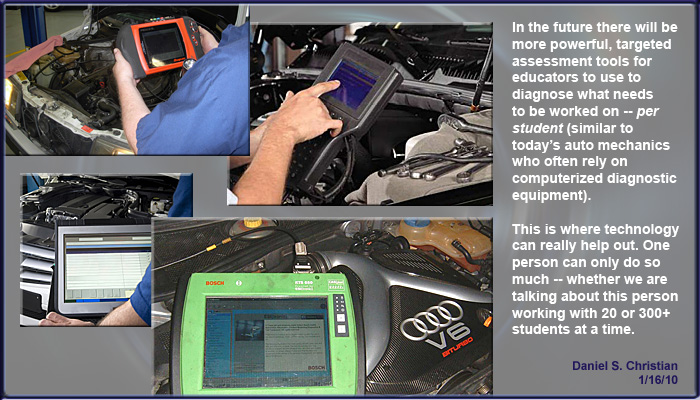Infographic from Collegestats.org
From DSC:
With thanks to Mr. Muhammad Saleem for the resource.
Also see:
- 12 research universities on the brink of extinction — also from CollegeStats.org




Infographic from Collegestats.org
From DSC:
With thanks to Mr. Muhammad Saleem for the resource.
Also see:
From DSC:
In real estate, one hear’s the mantra:
Location. Location. Location.
In higher education, I have it that we’ll be hearing this for a while:
Experimentation. Experimentation. Experimentation.
Consider the following reflections on Steve’ Kolowich’s solid article, The new intelligence (from InsideHigherEd.com)
Excerpt:
And for the largest public university in the country, it is hardly fiction. Arizona State University has become ground zero for data-driven teaching in higher education. The university has rolled out an ambitious effort to turn its classrooms into laboratories for technology-abetted “adaptive learning” — a method that purports to give instructors real-time intelligence on how well each of their students is getting each concept.
.
From DSC:
Besides being used in blended learning environments…some predictions:
It’s the sort of thing I was trying to get at with this graphic from 3 years ago:
.

Please don’t misunderstand me, the human mind is far beyond the complexity of an engine. But I still think that there will be more tools & technologies developed that will help the teachers/professors in their efforts to guide students into the knowledge of a discipline.
I beseech the corporate world to get involved more here — and not with the end goal of earning profits — but rather, with the aim of making the world a better place and giving a huge gift to the generations yet born.
I urge the corporate world to reach into their deep pockets (1.X trillion in cash at this point in time) and team up with our youth/teachers/professors/instructional designers/programmers/etc. to develop sophisticated, educationally-related, engaging games that are relevant to the world that our youth will be growing up in; and/or create interactive simulations that provide more choice/more control to the learners.
I urge more of the corporate world to join Knewton and Pearson and allocate some significant resources to help develop the next gen learning tools. I’ll bet that we’ll be amazed at what can be produced! Your daughters, sons, granddaughters, and grandsons will really appreciate the work that you did for them!!!
The hottest IT skills for 2013 — from itstrategynews.com
Top 4 traits of “future proof” employees, according to 1,709 CEOs — from forbes.com
What should you look for as you recruit new hires in 2013? As an employee yourself, what traits will serve you best in the years ahead?
Excerpt:
Late last year IBM conducted interviews with 1,709 CEOs around the world, and published the results in a white paper titled “Leading Through Connections.” It’s a fascinating look at how business leaders are reacting to recent convergence of digital, social and mobile technologies, known by many as the “connected economy.”
From DSC:
How are K-12 and higher ed doing on developing this type of employee?
Also see:
Book says ‘Big Data’ becoming a global nervous system — from USA TODAY by Chuck Raasch — with thanks to Ray Schroeder for the resource
Explosion of “Big Data” collection and analysis is hopeful, yet worrisome, trend
Excerpt:
Smolan, a former National Geographic photographer, built the book around a simple premise: That “big data” are becoming a “planetary nervous system,” the potential and consequences of which few have even started to contemplate.
It’s “an extraordinary knowledge revolution that’s sweeping, almost invisibly, through business, academia, government, health care and everyday life,” he says.
That revolution, he says, is being built on “a set of technologies coming together at just the right time, brought about by widespread and low-cost sensors that can now communicate with each other, the plummeting cost of computing power, the ubiquitous everywhere and always-on aspect of the Internet, the rapidly proliferating spread of smart devices.”
Also see:
Realtime analytics for education: Ontract wants to do for student data what Mint.com did for financial data — from techcrunch.com by Rip Empson
Excerpt:
The FERPA-compliant platform connects fragmented educational systems, like student information systems (SISes) and learning management systems (LMSes), collecting and analyzing student data to provide educators with greater insight into data metrics and analytics, without requiring a lengthy setup process or expensive configuration.
Big data in K-12: Is voice technology talking to you yet? (Part II) — from ednetinsight.com by Nelson B. Heller
Excerpt:
Read on to learn more about where we stand and some interesting examples of voice-powered educational products. (These articles are based in part on my recent “View From the Catbird Seat” presentation at EdNET 2012.)
Also see/relevant:
The use of neuroscientific data in educational practice — from Daniel Willingham’s Science and Education blog
Reflecting on the Top IT Issues of 2012 — from campustechnology.com by Dian Schaffhauser
Also see:
Involving students in IT — — from campustechnology.com by Keith Norbury
IT shops are turning to students to staff help desks, troubleshoot, and more. For schools, it’s a way to cut costs; for students, it’s a learning experience and a pathway to employment.
.
Predicting what topics will trend on Twitter — from MIT
Excerpt:
At the Interdisciplinary Workshop on Information and Decision in Social Networks at MIT in November, Associate Professor Devavrat Shah and his student, Stanislav Nikolov, will present a new algorithm that can, with 95 percent accuracy, predict which topics will trend an average of an hour and a half before Twitter’s algorithm puts them on the list — and sometimes as much as four or five hours before.
The algorithm could be of great interest to Twitter, which could charge a premium for ads linked to popular topics, but it also represents a new approach to statistical analysis that could, in theory, apply to any quantity that varies over time: the duration of a bus ride, ticket sales for films, maybe even stock prices.
Like all machine-learning algorithms, Shah and Nikolov’s needs to be “trained”: it combs through data in a sample set — in this case, data about topics that previously did and did not trend — and tries to find meaningful patterns. What distinguishes it is that it’s nonparametric, meaning that it makes no assumptions about the shape of patterns.
…
In principle, Shah says, the new algorithm could be applied to any sequence of measurements performed at regular intervals. But the correlation between historical data and future events may not always be as clear cut as in the case of Twitter posts. Filtering out all the noise in the historical data might require such enormous training sets that the problem becomes computationally intractable even for a massively distributed program. But if the right subset of training data can be identified, Shah says, “It will work.”
Excerpt:
Agarwal believes that education is about to change dramatically. The reason is the power of the Web and its associated data-crunching technologies. Thanks to these changes, it’s now possible to stream video classes with sophisticated interactive elements, and researchers can scoop up student data that could help them make teaching more effective. The technology is powerful, fairly cheap, and global in its reach. EdX has said it hopes to teach a billion students.
.
Which brings me to this graphic:

Also see:
IBM’s Watson expands commercial applications, aims to go mobile — from singularityhub.com by Jason Dorrier
.
From DSC:
This relates to what I was trying to get at with the posting on mobile learning. I would add the word “Education” to the list of industries that the technologies encapsulated in Watson will impact in the future. Combine this with the convergence that’s enabling/building the Learning from the Living [Class] Room environment, and you have one heck of an individualized, data-driven, learning ecosystem that’s available 24 x 7 x 365 — throughout your lifetime!!!
.
Also relevant here are some visions/graphics I created from 2012 and from 2008:
.
![The-Living-Class-Room-Daniel-S-Christian---July-2012 The Living [Class] Room -- by Daniel Christian -- July 2012 -- a second device used in conjunction with a Smart/Connected TV](http://danielschristian.com/learning-ecosystems/wp-content/uploads/2012/07/The-Living-Class-Room-Daniel-S-Christian-July-2012.jpg)
.
.
.
Big Data in K-12: Attack of the Recommendation Engines – Part I –– from EdNetInsight.com by Nelson B. Heller, President, The HellerResults Group — Friday, October 12, 2012
Excerpt:
Big Data Meets Education
A wave of K-12 entrepreneurial initiatives sees the application of “big data” as the key to instructional technology’s Holy Grail—intelligent real-time differentiated instruction akin to working one-on-one with a brilliant personal instructor. Investors, aware of the powerful strides made in recommendation engines by Internet giants Google, Amazon, LinkedIn, Netflix, and Zynga, as well as for a host of military and commercial applications, see in big data education’s “next big thing.” In this and my next article, I’m going to explore what’s happening in this arena and in voice recognition technology, which, if you look under the hood, can be thought of as being driven by the same advances in data science and recommendation engines. These articles are based in part on my recent View From the Catbird Seat presentation at EdNET 2012. Read on to see what threats and opportunities this new frontier represents for your own organization.
Big data is creating big job demand — from readwriteweb.com by Brian Proffitt
Also see:
Google’s answer to Siri thinks ahead — from technologyreview.com by Tom Simonite
The company’s data stockpile and investment in AI means a smartphone helper that answers queries before you even ask them.